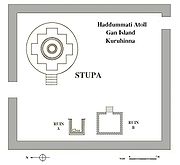
Haddhunmathi Atoll
Encyclopedia
Haddhunmathi or Haddummati Atoll (Laamu) is an administrative division of the Maldives. It corresponds to the natural atoll of the same name.
It is mostly rimmed by barrier reefs, the broadest of which are topped by islands. There are many islands along its eastern and southern boundaries.
This atoll is quite regular excepting for the projection of the reef at its NE corner (Isdhū Muli). It closely resembles Kolhumadulhu, its neighbour further north. Owing to its typical atoll shape, it differs in no respect from atolls in the Pacific Ocean, save for its greater size.
Its reefs are generally of little breadth, with no signs of vilu (deep pools), except for its eastern fringes which are covered with islands that are quite large by Maldive standards. The lagoon is comparatively open, containing scattered shoal patches; the bottom is muddy and the average depth is from 30 to 34 fathom (54.9 to 62.2 m).
Haddhummathi Atoll forms the southern limit of Central Maldives. Beyond the Huvadhu Kandu, the broadest channel between atolls in the Maldives, lie the southern atolls.
Traditionally, Maldivians call this atoll simply 'Haddhunmathi', without adding the word 'Atholhu' at the end. Before that the name of the atoll was 'Sathu Dhuvu mathi' named after the seven main islands.
Kadhdhoo Domestic Airport
is located in Kadhdhoo Island.
, Gan
and Isdhoo
. These are remains of monasteries, viharas and stupas of large proportions.
Some of the most ancient writings of the Maldives are the Isdhū Lōmāfānu
and the Dhanbidhū Lōmāfānu copperplates, relating to the conversion to Islam, the destruction of the Buddhist monuments, the beheading of the Buddhist monks and the building of mosques to replace the Buddhist temples and monasteries. These copperplates are from the year 1193 AD. The Maldivian king back then according to these documents was Sri Gadana Aditya Maharadun.
A tentative transcription of the Dhanbidū lōmafānu was made by M. Ibrahim Loutfi and was subsequently published in 'Faiytūra', the organ of the Maldivian Cultural Affairs Council.
 H. C. P. Bell excavated some of the Buddhist sites in 1923. The stupa
H. C. P. Bell excavated some of the Buddhist sites in 1923. The stupa
in Kuruhinna, one of the Buddhist sites in Gan Island, was remarkably well preserved. Only the Chattravali (Satihirutalu) was missing. Unfortunately these sites have been vandalized since then and there is almost nothing remaining now, except for a heap of stones and gravel.
The cause of heavy destruction during recent years has been archaeological excavations on those sites themselves. Regrettably, these investigations were either done carelessly, or left the site unprotected after excavation. The removal of the sheltering jungle exposed the site to subsequent vandalism. Often local inhabitants plundered the place in the vain hope of finding gold or other treasures, as soon as the archaeologists and accompanying government officials left the island.
The Dhanbidhū Lōmāfānu tells us that the Satihirutalu (the chattravali or chattrayashti crowning a stupa) were broken to disfigure the numerous stupas. It tells us also that statues of Vairocana
, the transcendent Buddha
of the middle world region, were destroyed; and the destruction was not limited to sculptures.
The wealth of manuscripts probably written on screwpine leaves that Maldivian monks in their Buddhist monasteries must have produced was either burnt
or otherwise so thoroughly eliminated that it has disappeared without leaving any trace. Therefore there are no samples of paintings from the Maldive Buddhist period itself. The only actual remains of the art of those times are a few sculptures and etchings on coral stone. Most of these are preserved in a little room in the Malé Museum, but many they are not properly labelled, so it is not easy to know where they come from.
A Buddha head found by H.C.P. Bell during his excavations in this atoll has disappeared, but the picture taken by Bell can be seen in his monograph.
It is mostly rimmed by barrier reefs, the broadest of which are topped by islands. There are many islands along its eastern and southern boundaries.
This atoll is quite regular excepting for the projection of the reef at its NE corner (Isdhū Muli). It closely resembles Kolhumadulhu, its neighbour further north. Owing to its typical atoll shape, it differs in no respect from atolls in the Pacific Ocean, save for its greater size.
Its reefs are generally of little breadth, with no signs of vilu (deep pools), except for its eastern fringes which are covered with islands that are quite large by Maldive standards. The lagoon is comparatively open, containing scattered shoal patches; the bottom is muddy and the average depth is from 30 to 34 fathom (54.9 to 62.2 m).
Haddhummathi Atoll forms the southern limit of Central Maldives. Beyond the Huvadhu Kandu, the broadest channel between atolls in the Maldives, lie the southern atolls.
Traditionally, Maldivians call this atoll simply 'Haddhunmathi', without adding the word 'Atholhu' at the end. Before that the name of the atoll was 'Sathu Dhuvu mathi' named after the seven main islands.
Kadhdhoo Domestic Airport
Kadhdhoo Airport
Kadhdhoo Airport or Kadhdhoo Domestic Airport is an airport located on the island of Kadhdhoo in Laamu Atoll, Maldives. The airport is northeast of Fonadhoo.-Facilities:...
is located in Kadhdhoo Island.
Buddhism in Haddhunmathi
This atoll was playing an important role in the Maldives when the nation was a Buddhist Kingdom. Many of the islands located on Haddhunmathi's eastern reef have important Buddhist archaeological sites, like Dhanbidhoo, MundooMundoo
Mundoo is the name of several geographic localities:*Mundoo, Queensland, a town in Australia*Mundoo , an island in the Maldives...
, Gan
Gan (Laamu Atoll)
Gan is one of the inhabited islands of Haddhunmathi Atoll, administrative code Laamu and the proposed capital for the Mathi-Dhekunu Province of the Maldives. Gan is the longest island of the Maldives...
and Isdhoo
Isdhoo
Isdhoo as a place name may refer to:* Isdhoo * Isdhoo...
. These are remains of monasteries, viharas and stupas of large proportions.
Some of the most ancient writings of the Maldives are the Isdhū Lōmāfānu
Lomafanu
Lōmāfānu or Loamaafaanu, also known by the Sanskrit name Sasanam, are Maldivian texts in the form of copper plates on which inscriptions have been added. The oldest of these plates dates from the twelfth century AD....
and the Dhanbidhū Lōmāfānu copperplates, relating to the conversion to Islam, the destruction of the Buddhist monuments, the beheading of the Buddhist monks and the building of mosques to replace the Buddhist temples and monasteries. These copperplates are from the year 1193 AD. The Maldivian king back then according to these documents was Sri Gadana Aditya Maharadun.
A tentative transcription of the Dhanbidū lōmafānu was made by M. Ibrahim Loutfi and was subsequently published in 'Faiytūra', the organ of the Maldivian Cultural Affairs Council.

Stupa
A stupa is a mound-like structure containing Buddhist relics, typically the remains of Buddha, used by Buddhists as a place of worship....
in Kuruhinna, one of the Buddhist sites in Gan Island, was remarkably well preserved. Only the Chattravali (Satihirutalu) was missing. Unfortunately these sites have been vandalized since then and there is almost nothing remaining now, except for a heap of stones and gravel.
The cause of heavy destruction during recent years has been archaeological excavations on those sites themselves. Regrettably, these investigations were either done carelessly, or left the site unprotected after excavation. The removal of the sheltering jungle exposed the site to subsequent vandalism. Often local inhabitants plundered the place in the vain hope of finding gold or other treasures, as soon as the archaeologists and accompanying government officials left the island.
The Dhanbidhū Lōmāfānu tells us that the Satihirutalu (the chattravali or chattrayashti crowning a stupa) were broken to disfigure the numerous stupas. It tells us also that statues of Vairocana
Vairocana
Vairocana is a celestial Buddha who is often interpreted as the Bliss Body of the historical Gautama Buddha; he can also be referred to as the dharmakaya Buddha and the great solar Buddha. In Sino-Japanese Buddhism, Vairocana is also seen as the embodiment of the Buddhist concept of shunyata or...
, the transcendent Buddha
Buddhahood
In Buddhism, buddhahood is the state of perfect enlightenment attained by a buddha .In Buddhism, the term buddha usually refers to one who has become enlightened...
of the middle world region, were destroyed; and the destruction was not limited to sculptures.
The wealth of manuscripts probably written on screwpine leaves that Maldivian monks in their Buddhist monasteries must have produced was either burnt
Book burning
Book burning, biblioclasm or libricide is the practice of destroying, often ceremoniously, books or other written material and media. In modern times, other forms of media, such as phonograph records, video tapes, and CDs have also been ceremoniously burned, torched, or shredded...
or otherwise so thoroughly eliminated that it has disappeared without leaving any trace. Therefore there are no samples of paintings from the Maldive Buddhist period itself. The only actual remains of the art of those times are a few sculptures and etchings on coral stone. Most of these are preserved in a little room in the Malé Museum, but many they are not properly labelled, so it is not easy to know where they come from.
A Buddha head found by H.C.P. Bell during his excavations in this atoll has disappeared, but the picture taken by Bell can be seen in his monograph.

